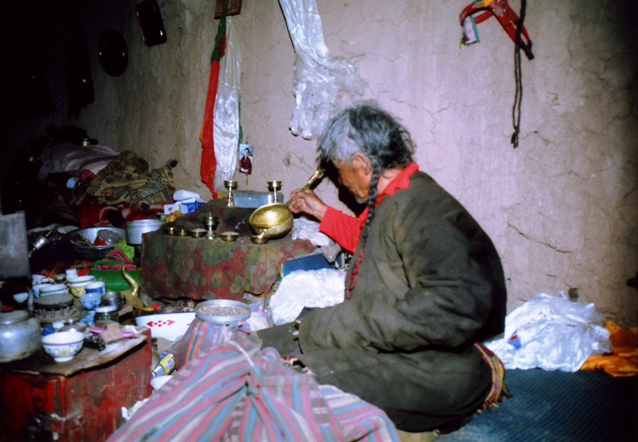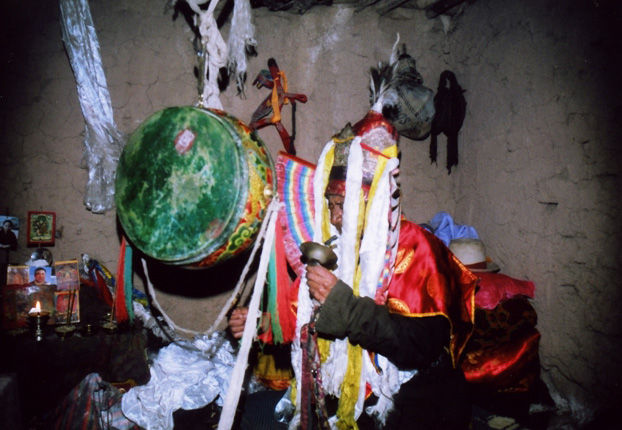
December 2009
John Vincent Bellezza
To generate or not to generate carbon emissions
This month, Flight of the Khyung tracks the gods of Tibet as they make their presence felt here on earth. It is getting cold up here in the Himalaya. Either you use an artificial source of heat or you bundle up in extra articles of clothing. People are sometimes perplexed when it is explained that you wear more clothes indoors than outdoors. Inside you tend to be more sedentary and thus require more protective layers. I avoid heating my hermitage with either wood or electricity on environmental grounds, not wanting to add to deforestation and greenhouse gases. I do however sometimes make an exception when people come to visit. In any case, being warm, or for that matter cold, is largely a state of mind. Certain physical and mental exercises can help to insure one’s comfort even in subfreezing temperatures. Diet is also a major factor in determining well-being in frigid surroundings.
Shamans reaching high above
This month we take a look at another spirit-medium or shaman of Upper Tibet, a man who pursues a vocation that never ceases to fascinate. What happens to the personal consciousness of a spirit-medium when he or she is purported to be under the possession of deities is a great enigma. If we take Tibetan ideas at face value, the spirit-mediums are being totally invaded by invisible divine beings. Needless to say, the modern rationalist cannot accept such a proposition. A reliance on faith notwithstanding, how can anyone believe in the gods without hard empirical evidence? Undoubtedly, a better accounting of the psychological aspects of spirit-possession in the scientific context is demanded.
What is clear from my close observations and acquaintance with spirit-mediums is that they are tapping into aspects of consciousness that are ordinarily inaccessible. These perforce must originate either inside or outside of their bodies. That in trance, spirit-mediums connect with something beyond themselves is only acceptable if we assume that consciousness can exist outside crania. But is consciousness so pervasive as to reach outside the organisms that nominally embody it? Impossible most neuroscientists would say, as there is no consciousness without a supporting neurophysiologic network. But in epistemological terms does consciousness really have an objectifiable origin or ultimate basis? The answer to this open-ended question will depend on one’s philosophical perspective, informed as it must by recent developments in quantum mechanics and astrophysics.
The life and work of Phowo Sridgyal
Phowo Sridgyal is undoubtedly one of Upper Tibet’s greatest contemporary spirit-mediums or lhapa. He is locally renowned for his kindness and great skill as a healer and oracle. It is not often that one meets an individual who emanates the holiness of Phowo Sridgyal. I had the good fortune to spend time with him on several occasions in the mid-2000s. Born in 1927, Phowo Sridgyal learned how to effectively channel the deities from Pönkya Gönpo Wanggyal, Namru’s senior-most spirit-medium in the mid-20th century. Pönkya Gönpo Wanggyal was the father of the late Phowo Lhawang (see Calling Down the Gods for biographical information on these noble healers). Phowo Sridgyal’s paternal uncle was also a spirit-medium, but he passed away when Phowo Sridgyal was still in his early teens.
In his early 20s, after becoming involuntarily possessed by the gods, Phowo Sridgyal experienced severe bodily pains. He sought help from Pönkya Gönpo Wanggyal, who lived less that one day’s ride away. Pönkya Gönpo Wanggyal cautioned Phowo Sridgyal not to attempt to be a lhapa until he had mastered all the basic techniques and traditions. Pönkya Gönpo Wanggyal counseled that a lhapa or lhamo practiced their vocation solely to help sentient beings and that their power must not be misused. The elder lhapa taught Phowo Sridgyal the various curative rituals needed in the practice of spirit-mediumship.
For several years, Pönkya Gönpo Wanggyal tutored the fledging lhapa, and performed the tsago (rtsa-sgo) rite for him. This entailed tying a cord around the ring finger of the left hand to regulate access to the subtle channels of Phowo Sridgyal’s body. It is believed that this was necessary to prevent demons from trespassing in his body. Pönkya Gönpo Wanggyal and Phowo Sridgyal would go into trance together on the first, eighth and fifteenth day of each lunar month. During these occasions, the entranced youth was made to describe the many visions that appeared in the ritual mirror (gling). Pönkya Gönpo Wanggyal let Phowo Sridgyal use some of his ritual equipment and later gave him many esoteric implements. Phowo Sridgyal’s initiation was completed when he reached 25 years of age. He married when he was around 29 and had four children with his wife, none of which practice as spirit-mediums.

Phowo Sridgyal preparing the altar for a trance ceremony
Phowo Sridgyal’s main deities of the trance are the white men and white horses of Mount Thanglha (Thang-lha mi-dkar rta-dkar), the Variegated Onager (rKyang-khra) and Tsen-gö Namra (bTsan-rgod nam-ra). The Thanglha gods reside on the eponymous mountain, one of Tibet’s most important territorial divinities. Phowo Sridgyal envisions them as clad in yellow armor and helmets and holding white ensigns in their right hands. Variegated Onager is a well-known territorial god (yul-lha) of the Namru district. Phowo Sridgyal states that Variegated Onager has both pacific and wrathful forms. In his pacific aspect he resembles a lama, while in his fierce form he is a red btsan spirit with bulging eyes and fangs. Tsen-gö Namra resides on a great black mountain in Bartha, and brandishes a black iron dagger and a red ensign.
Phowo Sridgyal reports going into trance dozens of times in a year. Sometimes patients come to his house or summer camp in groups of two or more vehicles. He has no fee schedule and treats the indigent free of charge. It is customary for those who can afford it to offer money or livestock for the services of a spirit-medium.
In the case of livestock diseases, Phowo Sridgyal resorts to fumigation with aromatic substances and the sprinkling of barleycorn, which are empowered by the presiding deities.

Phowo Sridgyal as the mountain god Namra
Special cords (srung-mdud) are braided for a variety of apotropaic and healing purposes. Like barleycorn, these cords are believed to be magically empowered by the deities of the trance once Phowo Sridgyal blows on them. Braided cords of white wool are thought by Phowo Sridgyal to be useful in a variety of diseases and for preventing obstructions to a patient’s long life and well being. Cords of black and white wool braided together are considered effective against arthritis and other body pains. Cords of black wool are used for diseases of the planets (gza’), which are primarily psychological and neurological in nature. Cords braided from the hair of a hare are said to be effective against livestock epidemics and are hung around the necks of animals. Phowo Sridgyal observes that cords made of brown bear hair are efficacious in life-threatening diseases and when all other remedies have failed. He keeps a small supply of brown bear hair for this purpose.
Phowo Sridgyal claims that the downy white feathers from an owl’s chest are efficacious in virtually all ailments. The small white feathers from the wings of the lammergeyer are used to increase the good luck potential (rlung-rta) and innate capability (dbang-thang) of patients. Feathers are also empowered while Phowo Sridgyal is possessed by the deities.
During one the of trance ceremonies I had the privilege to attend, the presiding deity was the ferocious Tsen-gö Namra. This mountain god announced his appearance through Pho-wo Sridgyal in poetic and somewhat cryptic language (as befits a supernatural being):
Listen to me carefully with the ears on the upper part of your body!
A kho re (an exclamation and lyrical phrase that draws attention to the spirit-medium and his utterances),
If you do not recognize me the btsan {like this}, yeah, the country residence of Handsome Body (gZugs mchor-po), yeah,
The country to which I bTsan mchor-po reside, yeah,
It is in the upper plain of {Ba ga thug = Bar-tha} in the east,
In the lower plain of {Ba ga thug} in the east.
On the 18 great secret paths [paths] in the east,
And on the pass of the adamantine lotus btsan,
And on the plain that is like a lotus,
And in the palace of the adamantine three peaks mountain,
And on the lotus ridgeline serchen flower,
There is the yellow btsan self-arising father god.
There is the spontaneously self-arising arched lotus rainbow.
Now that Tsen-gö Namra has made his presence known, he precedes to call on his army of warrior spirits (dgra-lha). The dgra-lha are invoked to aid and protect those attending the trance ceremony. These spirit warriors belong to Namra’s large retinue of divine helpers. Usually it is people that petition the dgra-lha, but here it is their divine leader that officiates over their invocation. So powerful is Namra perceived to be that in the observed trance ceremony he fulfilled the wishes of his minions with just one sacred word: bswo (pronounced so). The propitiation of the dgra-lha by oracles and diviners is an integral part of the first system or vehicle of Bon teaching known as Cha Shen (Phya gshen). Phowo Sridgyal, an illiterate Buddhist, has unwittingly preserved this ancient religious practice through an oral tradition of indeterminate but substantial age. For the first time ever, the cult of the dgra-lha in spirit-mediumship is presented in a translation of the actual words spoken. As they are intended to do, may these words benefit readers, wherever you go:
There are the young men, bswo, bswo, bswo (word of invocation)!
The mother and father territorial protectors of the dgra-lha,
The support of the good men, the males,
Eliminate the sudden onset misfortunes and obstacles of life,
And defeat the types of diseases of the demonic ’byung-po.
They defeat the diseases and demonic influences of the sudden onset obstructions.
Be the support of the men with the one span [long] body.
bSwo! bSwo! The sparkling snow mountain of sunrise,
The dgra-lha who is like the white lioness;
I praise you white lioness with the turquoise mane.
Realize their wishes whatever place they go.
I bswo (word of praise and offering) you, be the good guide whatever country they stay in.
Yeah, I praise the protector who looks like the white vulture in the good white vulture nest on the high red rock,
Your downy lammergeyer wings di ri ri (conveys a loud swooshing sound).
I bswo you flying flocks of birds khro lo lo (conveys a raucous chattering).
I bswo you, be the dgra-lha of males whatever place they go.
I bswo the tiger in Nepal in the sparkling forest.
I bswo the body god who is like the good red tiger.
I bswo you good red tiger with the six converging whorls.
You must be the good guide whatever place they go.
Be the protector of the good man, the one span [long] body.